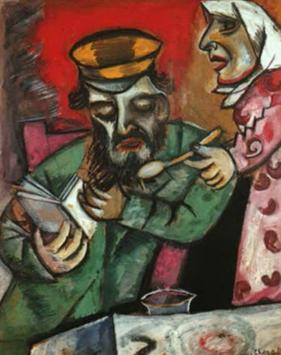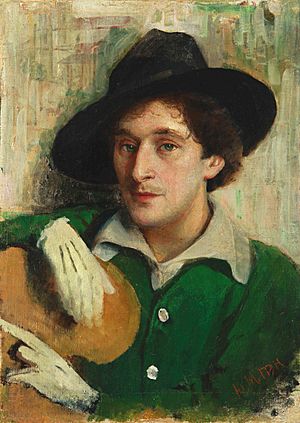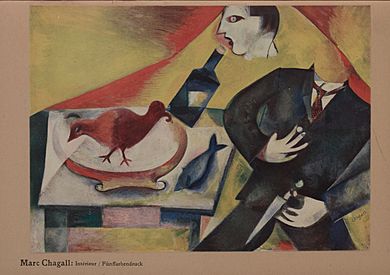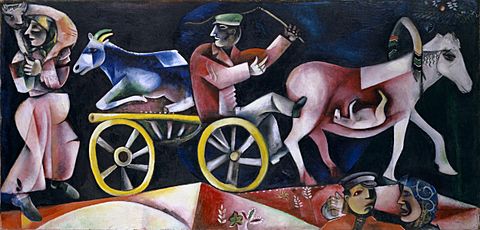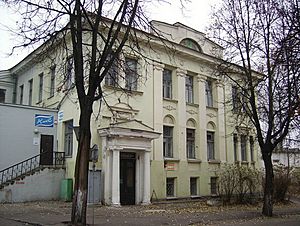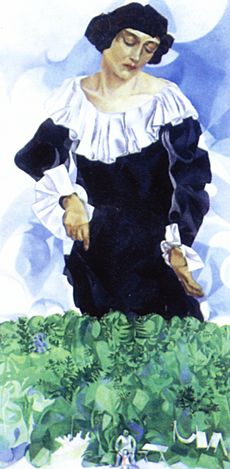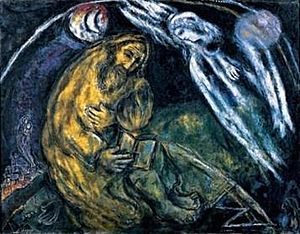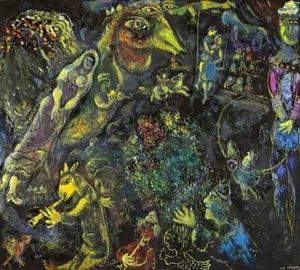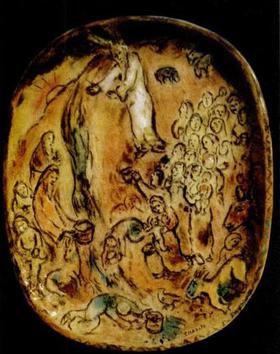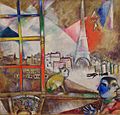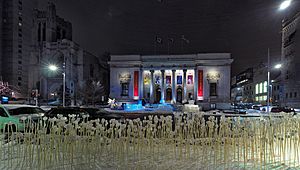Marc Chagall facts for kids
Quick facts for kids
Marc Chagall
|
|
|---|---|
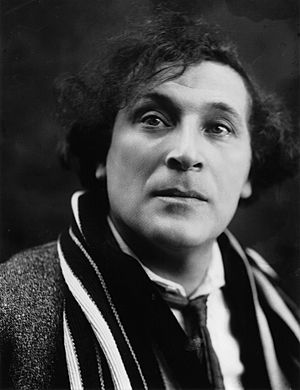
Chagall, c. 1920
|
|
| Born |
Moishe Shagal
6 July 1887 (N.S.) Liozna, near Vitebsk, Russian Empire
|
| Died | 28 March 1985 (aged 97) Saint-Paul-de-Vence, France
|
| Nationality | Russian subject, later French citizen |
| Known for |
|
|
Notable work
|
See list of artworks by Marc Chagall |
| Movement | |
| Spouse(s) |
|
Marc Chagall (born Moishe Shagal; 6 July 1887 – 28 March 1985) was a famous Russian-French artist. He was one of the first modern artists. He worked in many different art styles and created paintings, drawings, book pictures, stained glass, stage sets, ceramics, and tapestries.
Chagall was born in 1887 into a Jewish family near Vitebsk. This area is now in Belarus, but it was part of the Russian Empire back then. Before World War I, he traveled between Saint Petersburg, Paris, and Berlin. During this time, he created his own unique art style. It mixed modern art with ideas from Eastern Europe and Jewish folk culture.
He spent the war years in his home country, Belarus. He became a very important artist there. He even started the Vitebsk Arts College. Later, he worked in and near Moscow during a difficult time in Russia. In 1923, he moved back to Paris. During World War II, he escaped from occupied France to the United States. He lived in New York City for seven years before returning to France in 1948.
Many art experts called Chagall "the most important Jewish artist of the twentieth century." He was also seen as "the last survivor of the first group of European modern artists." He made beautiful stained glass windows for famous cathedrals like Reims and Metz. He also made windows for the Fraumünster in Zürich, the United Nations, the Art Institute of Chicago, and the Jerusalem Windows in Israel. He also created large paintings, including part of the ceiling of the Paris Opéra.
He was known for two main things: being a pioneer of modern art and being a major Jewish artist. He lived through modern art's "golden age" in Paris. There, he combined styles like Cubism, Symbolism, and Fauvism. Even with these different styles, he always remained a Jewish artist. His art was like a long, dreamy memory of life in his home village of Vitebsk. The famous artist Pablo Picasso once said, "When Matisse dies, Chagall will be the only painter left who understands what color really is."
Contents
- Early Life and Art Training
- Art Career Highlights
- Chagall's Art Style
- Other Art Forms
- Final Years and Passing
- Images for kids
- Legacy and Impact
- Theatre Productions
- Awards and Exhibitions
- See also
Early Life and Art Training
Growing Up in Vitebsk

Marc Chagall was born Moishe Shagal in 1887. He was part of a Jewish family in Liozna, near the city of Vitebsk. At that time, Vitebsk was in the Russian Empire. About half of the city's 66,000 people were Jewish. It was a beautiful city with many churches and synagogues.
Chagall was the oldest of nine children. His father, Khatskl Shagal, worked for a herring seller. His mother, Feige-Ite, sold groceries from their home. His father worked very hard but earned little money. Chagall later used fish in his art to show respect for his father.
Jewish people in the area often made clothes, furniture, and farm tools. From the late 1700s until World War I, the Russian government made Jews live in a special area called the Pale of Settlement. This led to many Jewish villages, called shtetls, with their own markets, schools, and hospitals.
Chagall remembered feeling like an outsider because he was Jewish. He wrote about scary times when people were unkind to Jews. He once thought, "My death would be useless. I really wanted to live."
Most of what we know about Chagall's early life comes from his book, My Life. He wrote about how much Hasidic Judaism influenced his art. He wanted to record Jewish traditions because he saw them disappearing. Vitebsk was a center for this culture.
Starting His Art Journey
Jewish children in the Russian Empire were not allowed to go to regular schools. So, Chagall first went to a Jewish religious school. There, he studied Hebrew and the Bible. When he was 13, his mother helped him get into a regular high school. She paid the headmaster 50 roubles to let him in.
A big moment for him was when he saw another student drawing. Chagall had never seen art at home. He later said it was like a "vision." He started copying pictures from books and loved it. He then decided he wanted to be an artist.
His mother didn't understand why he wanted to be a painter. It seemed like an unusual job. But Chagall explained, "There's a place in town; if I'm accepted... I'll come out a regular artist. I'd be so happy!" In 1906, he found the studio of Yehuda Pen, a realist artist who taught drawing in Vitebsk. Pen taught Chagall for free because he was young and had no money. But after a few months, Chagall realized that Pen's style of realistic portraits wasn't what he wanted to do.
Finding His Artistic Voice
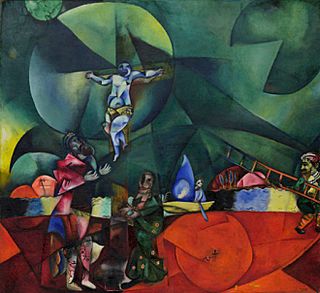
During this time in Russia, Jewish artists could either hide their Jewish background or show it in their art. Chagall chose to celebrate his Jewish roots and put them into his work. This was his way of expressing himself.
His art was deeply connected to his early life. The spirit of Hasidic Judaism was a main source for his art. Even when he became a famous artist, his ideas for pictures always came from his childhood. He remembered the snowy streets, wooden houses, and fiddlers of Vitebsk. These memories were so strong that he often used the same symbols in his art.
Art Career Highlights
Early Years in Russia (1906–1910)
In 1906, Chagall moved to Saint Petersburg. This was the capital of the Russian Empire and a center for art. Jews needed a special pass to enter the city, so he got a temporary one from a friend. He joined a good art school and studied there for two years. By 1907, he was painting self-portraits and landscapes.
From 1908 to 1910, Chagall studied with Léon Bakst. Bakst was a famous designer for stage sets and costumes. He helped Chagall by showing him that a Jewish artist could be successful. After four years of studying art, Chagall became part of the modern art world.
Chagall stayed in Saint Petersburg until 1910. He often visited Vitebsk, where he met Bella Rosenfeld. He described meeting her: "Her silence is mine, her eyes mine. It is as if she knows everything about my childhood, my present, my future." Bella wrote that his eyes were "as blue as if they'd fallen straight out of the sky."
Moving to France (1910–1914)
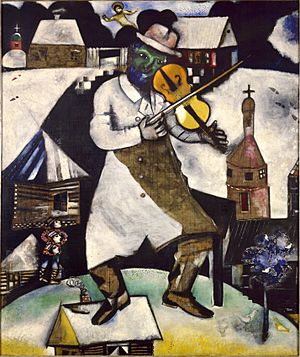
In 1910, Chagall moved to Paris to develop his art style. When he arrived, Cubism was very popular. But Chagall brought his own unique style from Russia. He had a great sense of color, strong feelings, and a love for simple poetry and humor. These ideas were new to Paris. He became friends with poets like Blaise Cendrars and Guillaume Apollinaire.
His first days in Paris were hard. He was lonely and couldn't speak French. Sometimes he wanted to go back to Russia. He often dreamed about Russian folk stories, his Jewish experiences, his family, and especially Bella.
In Paris, he went to an art school called Académie de La Palette. He also visited many art galleries and museums, like the Louvre. He admired artists like Rembrandt and van Gogh. In Paris, he learned a painting technique called gouache, which he used to paint scenes from Belarus. He loved just "breathing Parisian air."
Even in Paris, Chagall always thought about his home in Vitebsk. He painted Jewish subjects and scenes from his memories of Vitebsk. He also included Parisian scenes, like the Eiffel Tower. Many of his works were new versions of paintings he made in Russia, but now in Fauvist or Cubist styles.
Chagall created many unique images: floating figures, a giant fiddler dancing on tiny houses, and animals. Most of his Vitebsk scenes were painted while he was in Paris. They were like dreams, showing a feeling of longing and loss. His strange animal-human figures and flying people later influenced Surrealism. However, Chagall didn't want his art to be part of any specific art movement. He felt his symbols were personal to him.
Back in Russia (1914–1922)
Chagall missed his fiancée, Bella, who was still in Vitebsk. He was afraid of losing her. So, he decided to accept an invitation to show his art in Berlin. He planned to go to Belarus, marry Bella, and then return to Paris. He took 40 paintings and 160 drawings to the exhibit. It was a huge success, and German art critics loved his work.
After the exhibit, he went to Vitebsk. He only planned to stay long enough to marry Bella. But a few weeks later, World War I started, and the Russian border closed. A year later, he married Bella Rosenfeld, and they had their first child, Ida. Bella's parents were worried about her marrying a poor painter. This made Chagall even more determined to become a successful artist. His paintings from this time show the happy couple floating over Vitebsk.
In 1915, Chagall started showing his art in Moscow and St. Petersburg. This made him well-known, and rich collectors began buying his art. He also started drawing pictures for Yiddish books. By age 30, Chagall was famous.
The October Revolution of 1917 was a difficult time for Chagall, but it also brought new chances. He was often hungry. He felt that the new government had turned Russia "upside down." By then, he was one of Russia's most important modern artists. He was offered a high position in the arts, but he chose a less political job as art leader for Vitebsk. There, he founded the Vitebsk Arts College, which became a top art school in the Soviet Union.
He brought in important artists like El Lissitzky and Kazimir Malevich to teach. He also invited his first teacher, Yehuda Pen. Chagall wanted artists to work together but keep their own styles. However, some teachers preferred a different art style and didn't like Chagall's ideas. So, Chagall left his job and moved to Moscow.
In Moscow, he became a stage designer for the new State Jewish Chamber Theater. He created large background murals for their plays. One mural was about 9 feet tall and 24 feet long. It showed dancers, fiddlers, acrobats, and farm animals. One critic called it "Hebrew jazz in paint." These murals were very important for theater history. They were also early examples of his later large works, like murals for the New York Metropolitan Opera and the Paris Opera.
World War I ended in 1918, but the Russian Civil War continued, and there was a famine. The Chagalls had to move to a smaller, cheaper town near Moscow. Chagall had to travel to Moscow every day on crowded trains. In 1921, he taught art at a Jewish boys' shelter. He also drew pictures for a Yiddish poetry book called Grief.
After living in tough conditions, he decided to go back to France. He wanted to develop his art in a more comfortable country. Many other artists were also leaving for the West. While waiting for his visa, he wrote his autobiography, My Life.
Return to France (1923–1941)
In 1923, Chagall left Moscow and returned to France. On his way, he stopped in Berlin to get back his old paintings from an exhibit ten years earlier. But he couldn't find any of them. Still, back in Paris, he felt free again. Since his early works were lost, he started painting from his memories of Vitebsk.
He began working with a French art dealer named Ambroise Vollard. This led him to create etchings for illustrated books, including Gogol's Dead Souls, the Bible, and La Fontaine's Fables. These became some of his best printmaking works. In 1926, he had his first exhibit in the United States, but he stayed in France, painting constantly. By 1927, he became well-known in the French art world.
During this time, he traveled around France and the Côte d'Azur. He loved the landscapes, colorful plants, the blue Mediterranean Sea, and the warm weather. He often took his sketchbook on these trips.
Illustrating the Bible
After a trip, Vollard asked Chagall to illustrate the Old Testament. Chagall used this chance to travel to Israel to experience the Holy Land himself. In 1931, Marc Chagall and his family visited Tel Aviv. They stayed at the home of Meir Dizengoff, who wanted Chagall to help build a Jewish Art Museum there.
Chagall stayed in Israel for two months. He felt at home because many people spoke Yiddish and Russian. He was impressed by the people building new communities and was deeply moved by the Wailing Wall and other holy places.
Chagall later said Israel gave him "the most vivid impression he had ever received." He felt that being in the land of his ancestors helped him with his Bible illustrations. He said, "In the East I found the Bible and part of my own being."
He then focused on "the history of the Jews, their struggles, prophecies, and disasters." This was a big risk for Chagall, as he was already a famous modern painter. But he was now going back to ancient themes. Between 1931 and 1934, he worked very hard on "The Bible." He even went to Amsterdam to study biblical paintings by Rembrandt and El Greco. He walked through the city's Jewish quarter to feel the old atmosphere again.
Chagall saw the Old Testament as a "human story." He focused on the creation of humans, not just the universe. He often showed angels mixed with human figures. For example, in one early Bible picture, "Abraham and the Three Angels," the angels sit and chat over wine "as if they have just dropped by for dinner."
He returned to France and finished 32 of 105 plates by the next year. By 1939, when World War II began, he had finished 66. However, Vollard died that same year. The series was finally completed in 1956 and published. The illustrations were amazing and very popular. Chagall showed again that he was one of the most important graphic artists of the 20th century.
Escaping World War II
Soon after Chagall started working on the Bible, Adolf Hitler came to power in Germany. Anti-Jewish laws were made, and the first concentration camp was built.
From 1937, about twenty thousand artworks were taken from German museums. They were called "degenerate" by a group led by Joseph Goebbels. The German newspapers, which once praised Chagall, now made fun of his art. They called his paintings "green, purple, and red Jews shooting out of the earth, fiddling on violins, flying through the air." They said his art was an "attack on Western civilization."
After Germany took over France, the Chagalls stayed in Vichy France. They didn't know that French Jews were being sent to German concentration camps. The French government, working with the Nazis, started taking away French citizenship from many people, including Jews. Chagall was so busy with his art that he didn't realize the danger until October 1940. He learned that Jews were being removed from public jobs. The Chagalls finally "woke up to the danger they faced." But by then, they were trapped. Their only safe place was America, but they couldn't afford the trip or the money needed to enter the country.
Their daughter Ida realized they needed to act fast. With help from Alfred Barr of the New York Museum of Modern Art, Chagall's name was added to a list of important artists whose lives were in danger. Varian Fry, an American journalist, and Hiram Bingham IV, an American Vice-Consul, helped artists and thinkers escape Europe. They gave them fake visas to the US. In April 1941, Chagall and his wife lost their French citizenship. They were arrested in a hotel in Marseille with other Jews. Varian Fry managed to get them released. Chagall was one of over 2,000 people saved by this effort. He left France in May 1941, just in time. Picasso and Matisse were also invited to America but chose to stay in France. Chagall and Bella arrived in New York on 23 June 1941. Ida and her husband followed with many of Chagall's artworks.
Life in the United States (1941–1948)
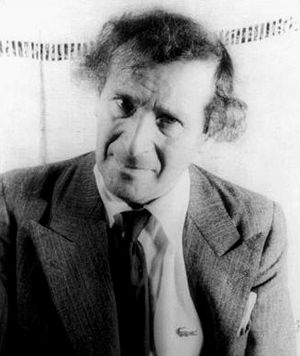
Even before he arrived in the United States in 1941, Chagall won a prize for his painting "Les Fiancés" in 1939. In America, he found out he was already a famous artist. But he felt out of place in a new country where he couldn't speak the language. He felt lost in the strange surroundings.
After some time, he started to get used to New York. The city was full of writers, painters, and composers who had also fled Europe. He visited galleries and museums and became friends with other artists.
Chagall loved visiting the Jewish neighborhoods in New York, especially the Lower East Side. He felt at home there, enjoying the Jewish foods and reading Yiddish newspapers.
At first, many American artists didn't understand Chagall's art. They didn't have much in common with a "folkloristic storyteller of Russo-Jewish background with a love for mystery." But things started to change when Pierre Matisse, the son of the famous French artist Henri Matisse, became his art dealer. Pierre Matisse organized Chagall exhibitions in New York and Chicago in 1941. One of the first shows included 21 of his best works from 1910 to 1941.
Aleko Ballet (1942)
The choreographer Léonide Massine asked Chagall to design the sets and costumes for his new ballet, Aleko. This ballet was based on Alexander Pushkin's poem The Gypsies with music by Tchaikovsky. The ballet was moved to Mexico to save money. Chagall had designed stage sets before in Russia, but this was his first ballet. It gave him a chance to visit Mexico. He quickly liked the "simple ways and colorful art of the Mexicans." He found it similar to his own style. He created four large backdrops and had Mexican seamstresses sew the costumes.
When the ballet opened in Mexico City on 8 September 1942, it was a "remarkable success." Famous mural painters like Diego Rivera came to see Chagall's work. When the music ended, there was huge applause, and Chagall was called back to the stage many times. The show then moved to New York, where it was also a big hit.
Dealing with World War II
After Chagall returned to New York in 1943, current events started to influence his art. He painted scenes of the Crucifixion and war. He learned that his hometown, Vitebsk, had been destroyed by the Germans, which made him very sad. He also learned about the Nazi concentration camps.
On 2 September 1944, Bella suddenly died from a virus. Chagall stopped working for many months. When he started painting again, his first pictures were about remembering Bella.
After living with his daughter Ida for a year, he started a relationship with Virginia Haggard. They had a child together, David McNeil, born in 1946. Virginia wrote about her seven years with Chagall in her book, My Life with Chagall.
After the War
By 1946, Chagall's art was becoming even more famous. The Museum of Modern Art in New York had a big exhibition of his work. It showed 40 years of his art and how his style changed. The war had ended, and he planned to return to Paris. He felt even more connected to Paris than before.
He moved back for good in the autumn of 1947. He went to the opening of an exhibition of his works at the Musée National d'Art Moderne.
Later Years in France (1948–1985)
After returning to France, he traveled around Europe. He chose to live in the Côte d'Azur, which was an "artistic center" at the time. Matisse lived nearby, and Picasso lived in Vallauris. Even though they lived close and sometimes worked together, they were artistic rivals. They never became close friends.
In April 1952, Virginia Haggard left Chagall.
Chagall's daughter Ida introduced him to Valentina (Vava) Brodsky in 1952. She was from a similar Russian Jewish background and had a successful hat business in London. She became his secretary. After a few months, she agreed to stay only if Chagall married her. They married in July 1952.
In the years that followed, he created not only paintings and graphic art but also many sculptures and ceramics. These included wall tiles, painted vases, plates, and jugs. He also started working on larger projects, such as big murals, stained glass windows, mosaics, and tapestries.
Paris Opera Ceiling (1963)
In 1963, Chagall was asked to paint the new ceiling for the Paris Opera (Palais Garnier). This was a grand 19th-century building and a national monument. André Malraux, France's Minister of Culture, wanted something special. He chose Chagall, but this caused some arguments. Some people didn't like a Russian Jew decorating a French monument. Others didn't want a modern artist painting a historic building.
Despite the arguments, Chagall continued the project. The 77-year-old artist took a year to finish it. The final painting was nearly 2,400 square feet (220 sq. meters) and used 440 pounds (200 kg) of paint. It had five sections that were glued to panels and lifted up to the 70-foot (21 m) ceiling. The images Chagall painted honored composers like Mozart and Wagner, as well as famous actors and dancers.
It was shown to the public on 23 September 1964. After the new ceiling was revealed, even those who were against it became quiet. The newspapers all said Chagall's work was a great addition to French culture. Malraux later said, "What other living artist could have painted the ceiling of the Paris Opera in the way Chagall did?... He is above all one of the great colorists of our time."
Chagall's Art Style
Using Color in Art
In all of Chagall's art, his colors always caught people's attention. In his early years, his colors were limited, but his pictures never looked like simple drawings. His colors were a living part of the picture. They shaped and brought life to the forms. They also created new ideas and blended tones. His colors didn't try to copy nature. Instead, they showed movement, layers, and rhythms.
He could create amazing images using only two or three colors. Chagall was very good at showing explosive movement with simple colors. Throughout his life, his colors created a "vibrant atmosphere" based on his own unique way of seeing things.
Subjects in His Art
From Memories to Fantasy
Chagall's early life gave him a strong visual memory and a talent for pictures. After living in France and feeling artistic freedom, his ideas grew. He created a new reality that mixed his inner thoughts with the outside world. But it was the images and memories from his early years in Belarus that kept his art going for over 70 years.
Some things in his art stayed the same throughout his career. One was his choice of subjects and how he showed them. He always had a gift for happiness and kindness. Even in serious subjects, he avoided being too dramatic. Musicians were always in his work. After he got married, "lovers have sought each other, embraced, floated through the air, met in wreaths of flowers." Acrobats moved gracefully, and flowers were everywhere.
His early pictures were often of his hometown, Vitebsk. They looked real and showed a moment in time, often with action. In his later years, like in the "Bible series," subjects were more dramatic. He mixed real things with fantasy. With his use of color, his pictures were always interesting. He never tried to show pure reality. Instead, he always created his moods through fantasy. In all cases, Chagall's most common subject was life itself, in its simple or complex forms. He showed places, people, and objects from his own life.
Jewish Themes
Chagall learned techniques from Fauvism and Cubism. He then mixed these styles with his own folk art. He made the difficult life of Hasidic Jews seem romantic and charming. By combining modern art with his "unique artistic language," he got the attention of art critics and collectors across Europe. His childhood in a Belarusian town gave him endless ideas. Chagall became one of many Jewish artists who later became famous.
World War I, which ended in 1918, caused many Jews to lose their homes. It also destroyed the traditional Jewish village culture that had existed for centuries. This meant that artists like Chagall had strong memories of that culture, but it no longer existed in real life. Instead, that culture became a source of emotion and ideas that only existed in his memory and imagination. This rich experience supported him for the rest of his life. If you asked Chagall to explain his paintings, he would say, "I don't understand them at all. They are not literature. They are only pictorial arrangements of images that obsess me."
In 1948, after returning to France from the U.S., he saw the destruction the war had brought to Europe and to Jewish people.
Chagall is seen as the most important visual artist to show the world of Eastern European Jews. He became a public witness to a civilization that was now gone. Even though Judaism has rules about pictures of religious subjects, Chagall used his fantasy images as visual metaphors mixed with folk art. His "Fiddler on the Roof," for example, shows a village setting with a fiddler. This represents the Jewish love of music as important to the Jewish spirit.
Music was very important in shaping his art. While he later loved the music of Bach and Mozart, in his youth he was mostly influenced by the music in the Hasidic community where he grew up. The Hasidic spirit was a deep source for his art.
However, Chagall had a complex relationship with Judaism. He said his Russian Jewish background was key to his art. But even if he had mixed feelings about his religion, he always used his Jewish past for artistic ideas. As an adult, he didn't practice Judaism, but through his paintings and stained glass, he tried to share a more "universal message." He used both Jewish and Christian themes.
He also wanted his work to be seen as more than just Jewish art. At the opening of The Chagall Museum in Nice, he said, "My painting represents not the dream of one people but of all humanity."
Other Art Forms
Stained Glass Windows
One of Chagall's biggest contributions to art was his work with stained glass. This art form allowed him to create intense and fresh colors. It also had the benefit of natural light changing the look of the glass. It wasn't until 1956, when he was almost 70, that he designed windows for the church at Assy. This was his first big project. Then, from 1958 to 1960, he created windows for Metz Cathedral.
Jerusalem Windows (1962)
In 1960, he started making stained glass windows for the synagogue at Hebrew University's Hadassah Medical Center in Jerusalem. The twelve windows represent the twelve tribes of Israel. Chagall saw the synagogue as "a crown offered to the Jewish Queen," and the windows as "jewels of translucent fire." Chagall spent the next two years on this project. When they were finished in 1961, the windows were shown in Paris and New York. They were put in Jerusalem in February 1962. Each window is about 11 feet (3.4 m) high and 8 feet (2.4 m) wide, much bigger than anything he had done before. Many consider them his greatest work in stained glass.
A French philosopher said, "Chagall reads the Bible and suddenly the passages become light." In 1973, Israel released a set of 12 stamps with images of these stained-glass windows.
The windows symbolize the twelve tribes of Israel who were blessed by Jacob and Moses in the Bible. In the synagogue, the windows form a symbolic guard of honor around the holy place.
Peace Window, United Nations (1964)
In 1964, Chagall created a stained-glass window called Peace for the UN. It honored Dag Hammarskjöld, the UN's second secretary general, who died in a plane crash in 1961. The window is about 15 feet (4.6 m) wide and 12 feet (3.7 m) high. It shows symbols of peace, love, and music. In 1967, the UN honored this artwork with a postage stamp.
Fraumünster in Zurich, Switzerland (1967)
The Fraumünster church in Zurich, Switzerland, is known for its five large stained glass windows created by Chagall in 1967. Each window is 32 feet (9.8 m) tall and 3 feet (0.9 m) wide. It's interesting how Christian symbols appear in the work of an artist from a Jewish background. Chagall often used Russian icons in his paintings, which included Christian symbols. His themes usually came from Bible stories. One panel shows Moses receiving the Torah. At the top of another panel is a picture of Jesus' crucifixion.
St Stephan's Church in Mainz, Germany (1978)
In 1978, he started creating windows for St Stephan's church in Mainz, Germany. Today, 200,000 visitors come each year to see the glowing blue stained glass windows by Marc Chagall. St Stephan's is the only German church for which Chagall created windows.
The church website says, "The colors speak directly to our feelings, because they tell of hope and joy in life." Monsignor Klaus Mayer worked with Chagall to create a sign of Jewish-Christian connection and international understanding. Mainz had been a very important Jewish community centuries ago. In 1978, at age 91, Chagall created the first window, and eight more followed. Chagall's helper, Charles Marq, added more stained glass windows using Chagall's typical colors.
All Saints' Church, Tudeley, UK (1963–1978)
All Saints' Church, Tudeley is the only church in the world where all twelve windows were decorated by Chagall. The other three religious buildings with full sets of Chagall windows are the Hadassah Medical Center synagogue, the Chapel of Le Saillant, and the Union Church of Pocantico Hills.
The windows at Tudeley were ordered by Sir Henry and Lady Rosemary d'Avigdor-Goldsmid. They were a memorial to their daughter Sarah, who died in 1963 at age 21. When Chagall saw the church for the first time in 1967, he said, "It's beautiful! I will do them all!" Over the next ten years, Chagall designed the other eleven windows. The last windows were put in place in 1985, just before Chagall died.
Chichester Cathedral, West Sussex, UK
On the north side of Chichester Cathedral, there is a stained glass window designed by Chagall when he was 90 years old. This was his last commissioned work. It was inspired by Psalm 150: "Let everything that has breath praise the Lord." The window was shown to the public in 1978.
America Windows, Chicago
Chagall visited Chicago in the early 1970s to install his mural The Four Seasons. While there, he was inspired to create stained glass windows for the Art Institute of Chicago. After talking with the Art Institute, Chagall decided the windows would honor the American Bicentennial. They would especially celebrate the United States' commitment to cultural and religious freedom. The windows were featured in the 1986 movie Ferris Bueller's Day Off. From 2005 to 2010, the windows were moved for cleaning and because of construction nearby.
Murals, Theatre Sets, and Costumes
Chagall first worked on stage designs in 1914 in Russia. He was inspired by the artist Léon Bakst. At that time, stage design was changing. Old ideas were replaced by new ways of thinking about space, colors, and rhythms. These changes interested Chagall, who was experimenting with Cubism. Designing murals and stage sets made Chagall's "dreams come to life."
Chagall played an important role in Russian art during that time. He helped create amazing new designs. Many of his designs were for the Jewish Theatre in Moscow. Chagall's set designs helped create magical atmospheres for the plays.
After leaving Russia, twenty years passed before he designed theatre sets again. In those years, his paintings still included clowns and acrobats. These showed his love for and memories of the theatre. His first stage design job after Russia was for the ballet "Aleko" in 1942, while he was in America. In 1945, he also designed sets and costumes for Stravinsky's Firebird. These designs greatly improved his reputation in America as a major artist. As of 2013, they are still used by the New York City Ballet.
Chagall's designs made the audience feel like they were in a bright, colorful fairy tale. His use of theatrical color reached its best when he returned to Paris. There, he designed the sets for Ravel's Daphnis and Chloë in 1958.
In 1964, he repainted the ceiling of the Paris Opera using 2,400 square feet (220 m2) of canvas. He painted two huge murals for the new Metropolitan Opera house at Lincoln Center in New York. These pieces, The Sources of Music and The Triumph of Music, were finished in France and shipped to New York. They are covered by panels during the day to prevent fading from sunlight. He also designed the sets and costumes for a new production of Die Zauberflöte (The Magic Flute) for the opera company.
Tapestries

Chagall also designed tapestries. These were woven by Yvette Cauquil-Prince, who also worked with Picasso. These tapestries are very rare. Chagall designed three tapestries for the state hall of the Knesset in Israel. He also designed 12 floor mosaics and a wall mosaic there.
Ceramics and Sculpture
Chagall started learning about ceramics and sculpture when he lived in southern France. Ceramics became popular in the Côte d'Azur. He took classes with other famous artists like Picasso. At first, Chagall painted on existing pottery. But soon, he started designing his own pieces. This began his work as a sculptor, which went along with his painting.
After trying pottery and dishes, he moved on to large ceramic murals. However, he was never happy with the limits of square tiles. He felt they stopped him from creating the images he wanted.
Final Years and Passing
Marc Chagall passed away in France in 1985. He was the last living master of European modern art. He lived through many big changes: the hopes and disappointments of the Russian revolution, the end of the Jewish settlements, the near destruction of Jewish people in Europe, and the complete ruin of his hometown, Vitebsk. Only 118 people out of 240,000 survived World War II in Vitebsk.
Chagall's last work was for the Rehabilitation Institute of Chicago. He had finished the painting for the tapestry called Job. But he died just before the tapestry was completed. Yvette Cauquil-Prince was weaving the tapestry under Chagall's guidance. She was the last person to work with him. She left his home at 4 pm on 28 March after discussing the final colors for the tapestry. He died that evening.
His connection with his Jewish identity was complex. He would have died without Jewish religious rites, but a Jewish stranger stepped forward and said the kaddish, the Jewish prayer for the dead, over his coffin. Chagall is buried next to his last wife, Valentina "Vava" Brodsky Chagall. They are in the cemetery in the artists' town of Saint-Paul-de-Vence, in France.
Images for kids
-
Marc Chagall, 1911, I and the Village, oil on canvas, 192.1 × 151.4 cm, Museum of Modern Art, New York
-
Marc Chagall, 1911, A la Russie, aux ânes et aux autres (To Russia, Asses and Others), oil on canvas, 157 x 122 cm, Musée National d'Art Moderne, Centre Pompidou, Paris
-
Marc Chagall, 1913, Paris par la fenêtre (Paris Through the Window), oil on canvas, 136 × 141.9 cm, Solomon R. Guggenheim Museum, New York
Legacy and Impact
Chagall was a "pioneer of modern art and one of its greatest figurative painters." He created a visual language that showed the excitement and fear of the twentieth century.
Art historians called Chagall a "poet, dreamer, and unique artist." They said that throughout his long life, he naturally played the role of an outsider. He seemed to be a link between different worlds: a Jew who ignored the old rules against making images, a Russian who went beyond his own country, and the son of poor parents who grew up in a large family. Yet, he became famous in the sophisticated art world.
Through his imagination and strong memories, Chagall used common themes in most of his work. These included village scenes, peasant life, and close-up views of the small Jewish village (shtetl). His calm figures and simple movements helped create a "monumental sense of dignity." He turned everyday Jewish rituals into a "timeless realm of iconic peacefulness." Chagall went beyond the limits of his time. He showed new possibilities for art that had lost touch with the Bible. In doing so, he created a new mix of Jewish culture that painting had ignored for a long time. Even though Chagall's art isn't only about religion, his most touching and original contributions, what he called "his message," come from religious or Biblical sources.
Andre Malraux praised him, saying: "[Chagall] is the greatest image-maker of this century. He has looked at our world with the light of freedom, and seen it with the colors of love."
Art Market Success
In 2017, a Chagall oil painting from 1928, Les Amoureux, sold for $28.5 million at an auction. This painting showed Bella Rosenfeld, his first wife, and his adopted home, Paris. This price almost doubled Chagall's previous auction record.
In 2010, his painting Bestiaire et Musique was the main item at an auction in Hong Kong. It showed a bride and a fiddler floating in a night sky with circus performers and animals. When it sold for $4.1 million, it became the most expensive modern Western painting ever sold in Asia.
In 2013, some unknown works by Chagall were found. They were hidden by the son of one of Hitler's art dealers.
Theatre Productions
In the 1990s, Daniel Jamieson wrote The Flying Lovers of Vitebsk. This play was about the lives of Chagall and his partner Bella. It has been performed many times. Most recently, in 2020, a production was streamed live from the Bristol Old Vic. It starred Marc Antolin as Chagall and Audrey Brisson as Bella Chagall. This show was made during the COVID pandemic, and the whole crew had to quarantine together to make it possible.
Awards and Exhibitions
Honors and Tributes
Chagall received several awards during his lifetime:
- In 1960, Brandeis University gave Marc Chagall an honorary degree.
- In 1977, the city of Jerusalem gave him the Yakir Yerushalayim (Worthy Citizen of Jerusalem) award.
- Also in 1977, the French government gave him its highest honor, the Grand-Croix de la Legion d'honneur.
- 1974: He became a member of the Royal Academy of Science, Letters and Fine Arts of Belgium.
- 1963 Documentary
A short 1963 documentary called Chagall featured the artist. It won an Academy Award for Best Short Subject Documentary in 1964.
- Postage Stamp Tributes
Because he was so famous and his art was popular, many countries have issued stamps to honor him. These stamps show examples of his works. In 1963, France issued a stamp of his painting, The Married Couple of the Eiffel Tower. In 1969, Israel produced a stamp showing his King David painting. In 1973, Israel released a set of 12 stamps with images of the stained-glass windows he created for the Hadassah Hebrew University Medical Center Synagogue. Each window represented one of the "Twelve Tribes of Israel".
In 1987, to celebrate 100 years since his birth, seven nations released special postage stamps in his honor. These countries included Antigua & Barbuda, Dominica, The Gambia, Ghana, Sierra Leone, and Grenada. They produced 48 stamps and 10 souvenir sheets. The stamps show his various masterpieces.
Art Exhibitions
There were many major exhibitions of Chagall's work during his life and after his death.
- In 1967, the Louvre in Paris showed 17 large paintings and 38 gouaches. This exhibit was called "Message Biblique." He gave these works to France on the condition that a museum would be built for them in Nice. In 1969, work began on the museum, named Musée National Message Biblique Marc Chagall. It opened on 7 July 1973, on Chagall's birthday. Today, it holds large paintings on Bible themes, three stained-glass windows, tapestries, a big mosaic, and many gouaches for the "Bible series."
- From 1969 to 1970, the Grand Palais in Paris held the largest Chagall exhibition ever, with 474 works. The exhibition was called "Hommage a Marc Chagall." It was opened by the French President and was very successful.
- The Dynamic Museum in Dakar, Senegal held an exhibition of his work in 1971.
- In 1973, he visited the Soviet Union, his first trip back since 1922. The Tretiakov Gallery in Moscow had a special exhibition for his visit. He saw the murals he had made for the Jewish Theatre again. In St. Petersburg, he met two of his sisters whom he hadn't seen in over 50 years.
- In 1982, the Moderna Museet in Stockholm, Sweden, organized a large exhibition that later traveled to Denmark.
- In 1985, the Royal Academy in London held a major exhibition that later traveled to Philadelphia. Chagall was too old to attend the London opening and died a few months later.
- In 2003, a major exhibition of Chagall's career was organized by museums in Paris, Nice, and the San Francisco Museum of Modern Art.
- In 2007, an exhibition of his work called "Chagall of Miracles" was held in Rome, Italy.
- The regional art museum in Novosibirsk had a Chagall exhibition on his biblical subjects in 2010.
- The Musée d'art et d'histoire du judaïsme in Paris had a Chagall exhibition called "Chagall and the Bible" in 2011.
- The Luxembourg Museum in Paris held a Chagall exhibition in 2013.
- The Jewish Museum in New York City has held many exhibitions on Chagall.
- Schirn Kunsthalle Frankfurt held an exhibition called "World in Turmoil" with paintings from the 1930s and 1940s in 2022-2023.
- Current Exhibitions and Permanent Displays

- Chagall's work can be found in many places. These include the 'Palais Garnier' (the Paris Opera), the Art Institute of Chicago, Chase Tower Plaza in downtown Chicago, the Metropolitan Opera, the Metz Cathedral, Notre-Dame de Reims, the Fraumünster abbey in Zürich, Switzerland, the Church of St. Stephan in Mainz, Germany, and the Musée Marc Chagall in Nice, France, which Chagall helped design.
- The only church in the world with a complete set of Chagall window-glass is in the small village of Tudeley, in Kent, England.
- Twelve stained-glass windows are part of Hadassah Hospital Ein Kerem in Jerusalem, Israel. Each window shows a different tribe.
- In the United States, the Union Church of Pocantico Hills has a set of Chagall windows honoring the prophets. These were ordered by John D. Rockefeller, Jr..
- Lincoln Center in New York City has Chagall's huge murals. The Sources of Music and The Triumph of Music are in the lobby of the new Metropolitan Opera House, which opened in 1966. Also in New York, the United Nations Secretariat Building has a stained glass wall of his work. In 1967, the UN honored this artwork with a postage stamp.
- The family home on Pokrovskaya Street, Vitebsk, is now the Marc Chagall Museum.
- The Museum of Biblical Art, Dallas, Texas, has one of the largest collections of Chagall's works on paper. They often have Chagall exhibitions.
- The Marc Chagall Yufuin Kinrin-ko Museum in Yufuin, Japan, has about 40–50 of his works.
- Marc Chagall's late painting called Job was for the Job Tapestry in Chicago.
- Other Tributes
During the closing ceremony of the 2014 Winter Olympics in Sochi, a Chagall-like float with clouds and dancers passed by. It hovered above 130 costumed dancers, 40 stilt-walkers, and a violinist playing folk music.
See also
 In Spanish: Marc Chagall para niños
In Spanish: Marc Chagall para niños


